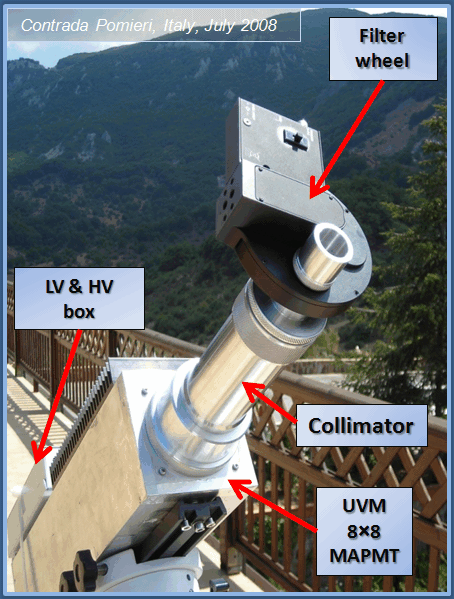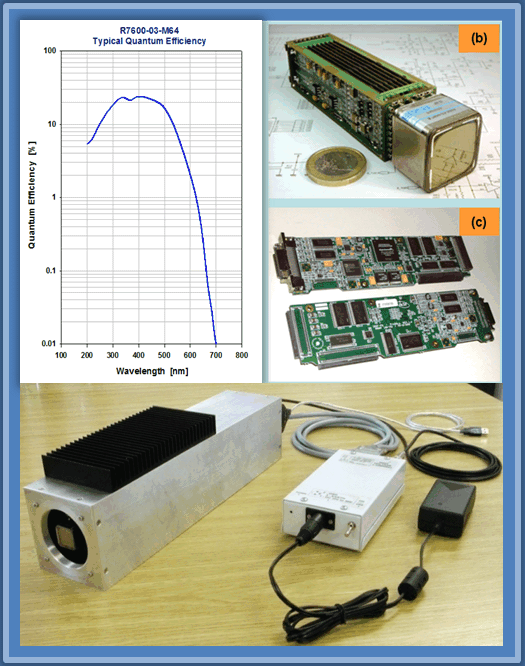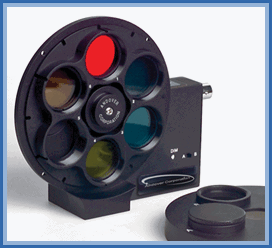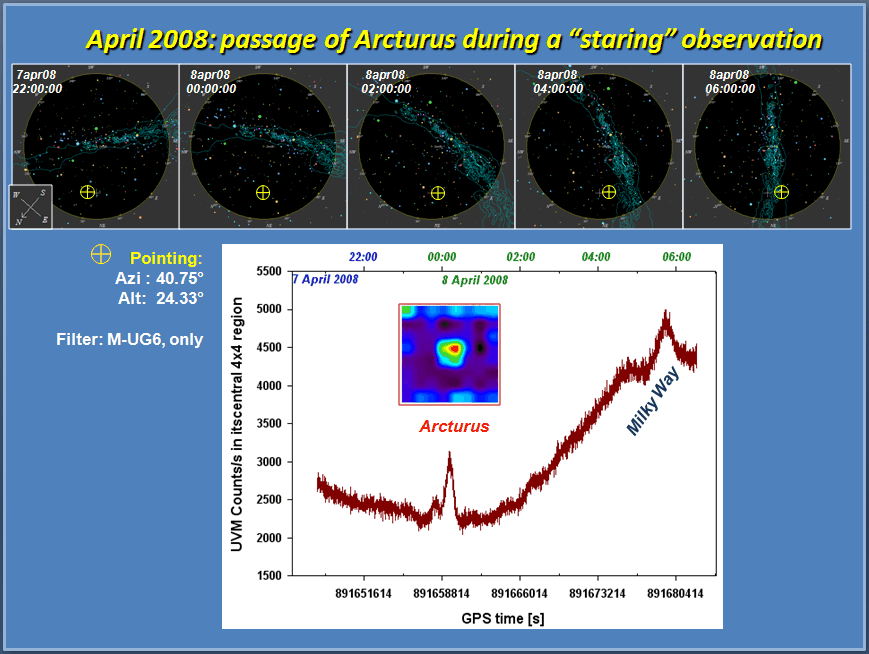
Introduction
The knowledge of the diffuse Night Sky Background light (NSB) level in the UltraViolet energy region is a necessary step in the analysis of cosmic rays detected by fluorescence experiments as well as in the case of Cherenkov telescopes. The NSB light depends on the geographic and atmosphere conditions, including humidity, pressure, dusts, airglow, moonlight, stars and planets, and so on. In particular, the environmental conditions influence the atmosphere composition and therefore can induce significant variations in the fluorescence yield, arising in uncertainty in the cosmic ray energy reconstruction.
The measurement of the diffuse NSB in the UV energy region (300-400 nm, roughly) is therefore a complementary and integrating part of the activities of the “cosmic rays and TeV gamma-ray astronomy” group of IASF-Palermo.
This activity, started in 1998 with the balloon-born experiment BaBy (Background Bypass), was subsequently performed through ground-based observations, firstly with the so-called “Baby on-ground,” and, since 2003, with the UVscope instrument.
The UVscope instrument is essentially a light detector working as photon counter. Its sensitive unit is a high speed response photomultiplier with efficiency extended to the UV band. In its first version, the detector of UVscope was a single-channel photomultiplier; under such a configuration (somewhere referred as “UVS”) and making use of a broad-band filter M-UG6, we were able to test the suitability of the basic instrument for NSB and sky transparency measurements at various locations: Contrada Pomieri, Madonie Mountains, Italy (2003); Calar Alto Observatory, Spain (2005); ARGO-YBJ, Tibet (2005); Pierre Auger Observatory, Argentina (2007, 2008, 2009).
Starting from Spring 2008, UVscope has been continuously upgraded: the detector is now a multi-anode photomultiplier that, with respect to the previous single-channel configuration, reduces the electronic dark noise to less than 10% and presents moderate imaging properties. Moreover, UVscope has been provided of a motorized filter wheel which allows to perform consecutive measurements at the different filter wavelengths. Under this UVscope configuration, campaigns of measurements have been conducted in Italy (Contrada Pomieri) and in Argentina (Pierre Auger Observatory).
Starting from the April 2009 campaign in Argentina, UVscope has also been remotely controlled from Italy too and, until 2012, it acquired data in a continuous way.
A similar UVscope unit (Experimental Astronomy, 51-2021) is currently active in the framework of the ASTRI program to monitor the NSB diffuse light of the Serra La Nave site where the ASTRI-Horn telescope is installed.
UVscope – The Apparatus at the Pierre Auger Observatory
 The UVscope Multianode apparatus basically consists of:
The UVscope Multianode apparatus basically consists of:
- a photon detector working in Single Photon Counting mode, coupled to its front-end and acquisition data electronics units and to a disk emulator interface card for computer connection;
- a collimator to regulate the angular aperture of the detector and to protect its sensitive area against stray light;
- a motorized filter wheel on which a set of UV filters can be accommodated, so allowing to observe the sky at different wavelengths.
The apparatus is completed by the power unit (low and high voltages), the star finder, the motorized tripod, the weather station, and a personal computer for remote control. The figure shows the UVscope minimal mounting on the tripod (without star finder) during a calibration test in Contrada Pomieri, Palermo, Italy, July 2008.
The Acquisition Unit, UVM
 The UVscope detector is a multi-anode photomultiplier Hamamatsu MAPMT R7600-03-M64, 8×8 pixels with typical Quantum Efficiency as shown in figure, left panel. Due to its multi-anode feature, the UVscope Acquisition Unit is somewhere referred as “UVM”.
The UVscope detector is a multi-anode photomultiplier Hamamatsu MAPMT R7600-03-M64, 8×8 pixels with typical Quantum Efficiency as shown in figure, left panel. Due to its multi-anode feature, the UVscope Acquisition Unit is somewhere referred as “UVM”.
The detector is coupled (panel b, in figure) to the front-end electronic unit of 64 channels (FEBrick), that amplifies and discriminates signals from the MAPMT; the FEBrick (top and bottom view, panel c, in figure) is in turn coupled to the data acquisition and handling unit (ProDAcq). The UVM connection to the computer is provided by a disk emulator interface card DELPHIN, developed at IASF-Pa; all these components (detector, front-end and read-out electronics, and interface card) are enclosed in a unique compact box. The power unit, that supplies and distributes low and high voltages, is contained in an external box.
Collimator and UVscope Geometry
The collimator of UVscope-UVM is about 158 mm long and its entrance pupil is a square of 4×4 mm2 to adapt itself to the pixellized geometry of the MAPMT. Under such a configuration, the UVM pixel Geometrical Factor (GF) is about 3.63×10-3 mm2 sr, the UVM pixel solid angle is 0.67 deg2 and the effective MAPMT angular aperture results in 6.6 deg.
Filters and Motorized Wheel
 UVscope is completed by a motorized filter wheel where a set of different optical filters can be accommodated; the wheel allows to perform consecutive measurements at the different wavelength bands of the filters.
UVscope is completed by a motorized filter wheel where a set of different optical filters can be accommodated; the wheel allows to perform consecutive measurements at the different wavelength bands of the filters.
The filter wheel currently utilized is the model FW-MOT-25 by Andover Corporation which can allocate up to 6 filters, 25 mm diameter each. The filter selection can be manually or remote-controlled through USB 2.0 interface or BNC input. The access time between two adjacent filters is of the order of 0.4 seconds.
The main set of filters utilized till now includes three narrow-band interferential filters (337, 355, 391 nm) and one broad-band M-UG6 filter (280-430 nm). During standard measurements, one location is maintained “closed” to monitor the dark current noise, and one location is maintained “open” for comparison with the global wavelength band proper of the MAPMT.
Star Finder, Tripod, Weather Station
The star finder in use with UVscope is a standard one. Correctly aligned with the collimator axis of UVscope, it is a very useful tool for all the pointing operations.
The tripod is the motorized steel model EQ6 Pro SkyWatcher with equatorial monitoring and positioning accuracy of the order of 1 arcminute. The GoTo motorization can be performed both manually via the SynScan keyboard, as well as through remote control thanks to the RS-232 port which SynScan is provided of.
The weather station is the WMR200-Professional model by Oregon Scientific; it allows to monitor and register many local meteo parameters (barometric pressure, humidity, temperature, wind, …) that will be utilized during the analysis phase of the UVscope data.
An example
 In April 2008 the UVscope-UVM apparatus was successfully tested, placed on the roof of the Los Leones building, Pierre Auger Observatory, Argentina. The figure shows the time profile (in counts/second) obtained during a “staring” observation (Azi=40.75°, Alt=24.33°) performed by using the M-UG6 filter. The long observation time (about 10 hours) allowed us to follow the variations of the diffuse NSB light, enhancing the passage of the Arcturus star through the UVscope field of view, and the approaching of the Milky Way towards our pointing direction.
In April 2008 the UVscope-UVM apparatus was successfully tested, placed on the roof of the Los Leones building, Pierre Auger Observatory, Argentina. The figure shows the time profile (in counts/second) obtained during a “staring” observation (Azi=40.75°, Alt=24.33°) performed by using the M-UG6 filter. The long observation time (about 10 hours) allowed us to follow the variations of the diffuse NSB light, enhancing the passage of the Arcturus star through the UVscope field of view, and the approaching of the Milky Way towards our pointing direction.